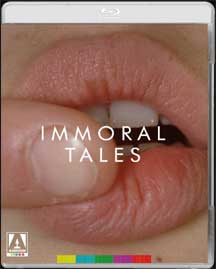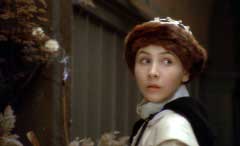 IMMORAL
TALES (1974) Blu-ray/DVD combo
IMMORAL
TALES (1974) Blu-ray/DVD comboDirector: Walerian Borowczyk
Arrow Films USA
 IMMORAL
TALES (1974) Blu-ray/DVD combo
IMMORAL
TALES (1974) Blu-ray/DVD comboWalerian Borowczyk's brand of classy erotica finally hits Blu-ray stateside with Arrow Video USA's combo release of the kinky portmanteau IMMORAL TALES.

In "The Tide", based on a story by André Pieyre de Mandiargues (whose novels would provide the source material for Borowcyzk's later LA MARGE/THE STREETWALKER and LOVE RITES as well as Jack Cardiff's GIRL ON A MOTORCYCLE), twenty-year-old André (Fabrice Luchini, later an accomplished stage and screen actor) takes advantage of a seaside picnic to teach virginal sixteen-year-old cousin Julie (Lise Danvers) about the mysteries of the tides. The act of oral sex between literal "kissing cousins" is more sexual exploitation than initiation with André describing the synchronization of his orgasm with the "coming in" of the tides as an exercise in self-control and telling Julie that it was not meant to be fun but educational. Although "Thérèse Philosophe" takes its title from a 1748 pornographic novel, the novel itself is a prop in the short and the events within only vaguely related. When Thérèse (Charlotte Alexandra, Catherine Breillat's A REAL YOUNG GIRL) is late in returning home after Sunday services, her grandmother punishes her even though the girl swears that she had remained in the church after mass; which she did, fondling various phallic objects including the bishop's crosier, the base of a statue, and the vibrating pipes of the organ. Left alone in the attic for three days with the Stations of the Cross and three ripe cucumbers intended for sustenance, Thérèse soon takes an interest in the room's suggestive contents: military regalia, a broken male doll, and the trunk of corsets that hides a stash of erotic photographs. When she stumbles upon a copy of the titular novel, she realizes that her ecstasy is carnal rather than spiritual and undertakes her own deflowering with the help of those cucumbers before escaping the attic and rushing headlong towards her fate. Unjustly punished for sexual curiosity, Thérèse is put up for beatification when her virtue is apparently "stolen" from her.
 The
third episode "Bathory" is the most ambitious and well-realized of
the quartet. Countess Erzsébet Bathory (Paloma Picasso), page Istvan
(Pascale Christophe, IMMORAL WOMEN), and her guards round up "simple and
honest" young women who the countess will reward with the opportunity to
experience "eternal joy" in touching her lace and pearl-strewn gown.
Bringing the girls back to the castle where they are showered and perfumed,
the "Bloody Countess" does not have to inflict upon them the tortures
exaggerated in historical accounts and fiction; instead, she lets them rip her
lace and pearl gown asunder and then tear each other to pieces to fill her youth-restoring
bath. The countess, however, turns out not to be the heroine of this tale, and
a life-saving betrayal allows masculine authority to reassert itself. "Lucrezia
Borgia" finds soon-to-be-martyred Dominican friar Savonarola (Philippe
Desboeuf, GERMINAL) accusing the church authority from the pulpit of dissolution,
summarily illustrated with a bit of historical license when Pope Alexander VI
(filmmaker Mario Ruspoli, billed as "Jacopo Berinizi") declares his
daughter Lucrezia's (Florence Bellamy, HOLY YEAR) new husband Giovanni Sforza
impotent and disposes of him through a trap door. The family line is ensured
in a threesome between father, daughter, and son Cesare (Ruspoli's real son
Fabrizio), and the Pope baptizes the child as Savonarola burns at the stake.
In real life, Sforza did accuse his wife of fraternal and paternal incest and
his father-in-law and brother-in-law of plotting to kill him once he proved
to be less of an asset than thought from his previous marriage to the daughter
of Federico I of Mantua. The marriage was annulled.
The
third episode "Bathory" is the most ambitious and well-realized of
the quartet. Countess Erzsébet Bathory (Paloma Picasso), page Istvan
(Pascale Christophe, IMMORAL WOMEN), and her guards round up "simple and
honest" young women who the countess will reward with the opportunity to
experience "eternal joy" in touching her lace and pearl-strewn gown.
Bringing the girls back to the castle where they are showered and perfumed,
the "Bloody Countess" does not have to inflict upon them the tortures
exaggerated in historical accounts and fiction; instead, she lets them rip her
lace and pearl gown asunder and then tear each other to pieces to fill her youth-restoring
bath. The countess, however, turns out not to be the heroine of this tale, and
a life-saving betrayal allows masculine authority to reassert itself. "Lucrezia
Borgia" finds soon-to-be-martyred Dominican friar Savonarola (Philippe
Desboeuf, GERMINAL) accusing the church authority from the pulpit of dissolution,
summarily illustrated with a bit of historical license when Pope Alexander VI
(filmmaker Mario Ruspoli, billed as "Jacopo Berinizi") declares his
daughter Lucrezia's (Florence Bellamy, HOLY YEAR) new husband Giovanni Sforza
impotent and disposes of him through a trap door. The family line is ensured
in a threesome between father, daughter, and son Cesare (Ruspoli's real son
Fabrizio), and the Pope baptizes the child as Savonarola burns at the stake.
In real life, Sforza did accuse his wife of fraternal and paternal incest and
his father-in-law and brother-in-law of plotting to kill him once he proved
to be less of an asset than thought from his previous marriage to the daughter
of Federico I of Mantua. The marriage was annulled.

Preceding producer Anatole Dauman's ventures into hardcore arthouse erotica IN THE REALM OF THE SENSES by Nagisa Ôshima and Shûji Terayama's STORY OF O sequel FRUITS OF PASSION (in which Klaus Kinski was rumored to have participated in the unsimulated sex), IMMORAL TALES was a relatively more commercial outing for Walerian Borowczyk compiling a handful of separately-realized shorts into a portmanteau film of sexual hypocrisy disguised as erotica (he would attempt this again with somewhat uneven results in IMMORAL WOMEN). Each looks at a different woman exploited, repressed, or liberated sexually with Lucrezia Borgia faring the best of the four while remaining a pawn in her family's power moves; had Borowczyk not deleted the original third story "The Beast of Gévaudan" (which he would rework into the feature THE BEAST), there would have been one heroine sexually liberated and escaping (unlike Thérèse who only gets so far out of the repressive confines). The shorts become increasingly stylized, all the more surprising that they were intended as separate entities given the effort of travelling to Sweden to shoot "Bathory" in a castle and sets which could be more cheaply realized there but probably would have been just as believable shot closer to home. The actors are largely stylized props Borowczyk's meticulously-designed vignettes probed by his handheld camera (compared to the intentional static and flat compositions of BLANCHE). The women are as well-served visually as the sets and erotic objets d'art, and the film is largely scored with evocative medieval folk music. Although not as outrageous as THE BEAST or THE STRANGE CASE OF DR. JEKYLL AND MISS OSBOURNE, the erotic (and pornographic) focus demonstrates his artistic and cinematic progression more explicitly than his earlier shorts and animated works.
 IMMORAL
TALES was released theatrically in the United States with an X-rating in its
English dub by New Line Cinema in 1976, and then on VHS by Charles Band's Force
Video. Anchor Bay's DVD featured a non-anamorphic 1.66:1 transfer that had English
and French tracks but burnt-in English subtitles while the UK's Nouveaux Pictures
DVD had an anamorphic transfer in French with burnt-in subtitles. When Arrow
Films announced the intent to crowd-fund the restoration of some of Borowcyzk's
early works, the campaign was so successful that the went ahead and struck new
HD masters of a couple of his other films which would then be released last
September as the 1000-copy limited edition CAMERA OBSCURA: THE FILMS OF WALERIAN
BOROWCZYK which featured Region ALL/Region 0 combos Borowczyk's early shorts,
animation, and the feature-length THEATRE OF MR AND MRS KABAL and another combo
of his first completely live-action feature BLANCHE and Region B/Region 2 combos
of GOTO: ISLE OF LOVE, IMMORAL TALES, and THE BEAST along with a tête-bêche
double-sided book featuring a set of essays on one side called CAMERA OBSCURA
and a collection of Borowczyk stories titled "Anatomy of the Devil".
The boxed set sold out quickly and individual combos would follow with some
of the content from the books available in essay booklets.
IMMORAL
TALES was released theatrically in the United States with an X-rating in its
English dub by New Line Cinema in 1976, and then on VHS by Charles Band's Force
Video. Anchor Bay's DVD featured a non-anamorphic 1.66:1 transfer that had English
and French tracks but burnt-in English subtitles while the UK's Nouveaux Pictures
DVD had an anamorphic transfer in French with burnt-in subtitles. When Arrow
Films announced the intent to crowd-fund the restoration of some of Borowcyzk's
early works, the campaign was so successful that the went ahead and struck new
HD masters of a couple of his other films which would then be released last
September as the 1000-copy limited edition CAMERA OBSCURA: THE FILMS OF WALERIAN
BOROWCZYK which featured Region ALL/Region 0 combos Borowczyk's early shorts,
animation, and the feature-length THEATRE OF MR AND MRS KABAL and another combo
of his first completely live-action feature BLANCHE and Region B/Region 2 combos
of GOTO: ISLE OF LOVE, IMMORAL TALES, and THE BEAST along with a tête-bêche
double-sided book featuring a set of essays on one side called CAMERA OBSCURA
and a collection of Borowczyk stories titled "Anatomy of the Devil".
The boxed set sold out quickly and individual combos would follow with some
of the content from the books available in essay booklets.

This September, Arrow Video USA has lined up Region AB/Region 1/2 combos of IMMORAL TALES and THE BEAST. Like the UK release, the domestic edition of IMMORAL TALES features two cuts of the film via seamless branching: the standard cut (103:08) available previously, and The Age d'Or Cut (125:25) – named after the Bunuel-titled award that this version won – featuring Borowcyzk's original cut "The Beast of Gévaudan" as the film's third story. "The Beast of Gévaudan" was preserved only as a 16mm copy since the original 35mm negative was recut for incorporation into the feature THE BEAST, so the quality is not as fine as it is in the feature version, but Arrow has taken care to clean it up as much as possible without obliterating available detail. The standard cut has a more consistent look, preserving the soft lighting, color schemes, and period detail of Borowczyk's props and sets, with only "Thérèse Philosophe" looking inferior because it was shot on 16mm reversal film and then blown-up to 35mm. The LPCM 1.0 French track is rich in terms of dialogue, music, and effects, and the optional English subtitles are literate and free of errors (the English dub included on the Anchor Bay release has not been included here).
 There
are, however, some supplementary differences between the UK editions and the
US release with the American edition dropping Borowczyk's short "A Private
Collection", a documentary about erotica from drawings to period mechanical
amusements, narrated by de Mandiargues that was originally intended as the prologue
to IMMORAL TALES but eventually shown on its own. It was included on the UK
edition in two cuts: the version more familiar to festival audiences (12:12),
and what has been titled "The Oberhausen Version" which runs about
two minutes longer at 14:31, although a brief moment of actual bestiality was
blacked in accordance with BBFC regulations and with the approval of producer
Duvergé).
There
are, however, some supplementary differences between the UK editions and the
US release with the American edition dropping Borowczyk's short "A Private
Collection", a documentary about erotica from drawings to period mechanical
amusements, narrated by de Mandiargues that was originally intended as the prologue
to IMMORAL TALES but eventually shown on its own. It was included on the UK
edition in two cuts: the version more familiar to festival audiences (12:12),
and what has been titled "The Oberhausen Version" which runs about
two minutes longer at 14:31, although a brief moment of actual bestiality was
blacked in accordance with BBFC regulations and with the approval of producer
Duvergé).

Carried over from the UK release is the Theatrical Trailer (2:18) as well as "Love Reveals Itself: Making IMMORAL TALES" featurette includes commentary by cameraman Noël Véry (THE ART OF LOVE) and assistant director Dominique Duvergé (BLANCHE) who recall how the project resulted from a meeting between Borowczyk, producer Dauman, and writer de Mandiargues. Véry describes how he ended up replacing Guy Durban (BLANCHE) and how quickly Borowczyk adapted to his hand-held style (Véry would be one of the first cameramen to use the Steadicam in France years later). Véry would work more hands on with replacement cinematographer Bernard Daillencourt (THE BEAST). Duvergé discusses the casting including Borowczyk approaching Isabelle Adjani for the role of Julie in "The Tide", then-unknown Luchini, Picasso (who later dismissed the film), and filmmaker Ruspoli and his son in the Borgia segment. No mention is made of IMDb's claim that the body double for the girl in the Bathory segment who hides a pearl in her vagina is supposedly Swedish softcore/hardcore actress Marie Forså (Sarno's BUTTERFLIES).
Ported over from the BLANCHE set is "Obscure Pleasures" (63:15) is a lengthy unreleased 1985 interview – re-edited by Daniel Bird – with the director conducted by Keith Griffiths for the BFI that focuses on the director's transition from graphic art to animation and filmmaking. The bulk of the discussion is rather academic but soon becomes adversarial when Griffiths asks about the director's preoccupation with sex and even calls him a pervert. Borowczyk turns the argument around to ask why the spectator is not implicated in consuming eroticism. The featurette also includes Noël Véry's home movies on the set of LA MARGE with Sylvia Kristel and Joe Dallessandro. From the animation set is Bird's visual essay "Blow Ups" (4:44) focusing on the director's paper works. The booklet that comes with the individual releases was not included for review, but the three-hundred-page-plus tête-bêche-bound book that came with the limited set featured a six-page essay by Daniel Bird and a reprint of a 1976 Philip Strick review on the film (presumably that was filled out with some of the other content from the book which also included short stories by Borowczyk, film-specific essays, and more general essays about Borowczyk's style and themes. (Eric Cotenas)